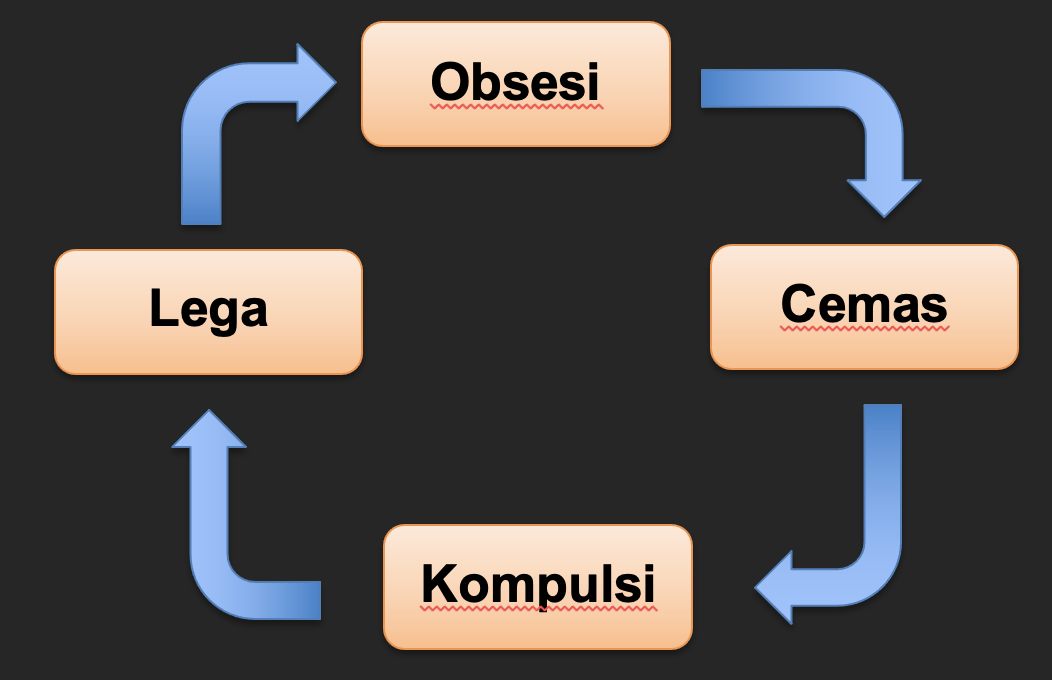
Obsessive Compulsive Disorder (OCD) is a mental disorder characterized by obsessions and/or compulsions. Obsessions are persistent and recurring thoughts, urges, or images that are perceived as intrusive and unwanted experiences. Meanwhile, compulsions are repetitive behaviors or mental acts carried out by individuals because they feel compelled to do so as a form of responding to obsessions or following rules that must be applied rigidly.

OCD prevalence ranges from 1.1% -1.8%. More women are affected by this disorder than men as adults, but men are more often affected in childhood. The average age of someone with OCD is 19 years, but 25% of cases can start at the age of 14 years. Onset over the age of 35 years is rare but can occur. Nearly 25% of men have an onset before the age of 10 years. People with OCD are usually aware that their thoughts and actions are excessive, but they can't fight it. OCD can be so disturbing to sufferers that it hinders various aspects of their lives.
What are the causes of OCD?
The cause of OCD is not known with certainty, but several factors that increase the risk of OCD include: genetic factors, disturbances in neurotransmitters (brain chemicals) such as serotonin and norepinephrine, temperamental factors (tend to have high negative emotions and internalize problems), and the presence of childhood trauma such as being subjected to abusive treatment, either physically or sexually, getting an infection and having experienced autoimmune symptoms due to infection.
What are the symptoms of OCD?
A symptom of OCD is having unwanted thoughts, urges, or images that cause significant anxiety or suffering. The sufferer will try to suppress or ignore these thoughts, urges or images, or even "neutralize" these things with other repeated actions (compulsions), for example washing hands, tidying up, checking, praying, counting, repeating words. certain slowly). OCD sufferers feel the need to take these actions to prevent or reduce anxiety, suffering, or prevent bad things from happening. But keep in mind, that compulsive actions are unrealistic or excessive when compared to normal ways to prevent or neutralize something. For example, sufferers of OCD who are afraid of being "contaminated" by germs tend to wash their hands excessively (there are certain rules, for example 5 times to rub their arms, 9 times to rub their palms, etc.) or to clean the house or take a shower too often. o'clock.
These obsessions and compulsions are extremely time-consuming (usually more than 1 hour per day) or cause significant impairment and distress in social, occupational, and other important areas of life. Symptoms of obsessions that appear are not the result of substance abuse or certain drugs, or other general medical conditions. OCD sufferers can sometimes feel embarrassed to tell the doctor what they are experiencing at the beginning of the appointment because they realize that their obsessions and compulsions are excessive and unnatural, but they find it difficult not to think or do those things.
An example of this is a person who feels that he has to check the stove 30 times so that a fire does not occur in his house. The person knows that his house won't necessarily catch fire if he doesn't check the stove 30 times, but the thought of checking the stove 30 times (obsession) keeps coming up so that he ends up having to check the stove 30 times (compulsion) to keep himself calm.
Some of the themes frequently associated with OCD are Cleanliness (obsession with contamination and compulsion with cleaning); Symmetrical (obsession with being symmetrical and compulsions with checking, sorting, and counting); Taboo or forbidden thoughts (aggressive, sexual, or religious obsessions and compulsions related to these); and Hurt (fear of hurting self or others and compulsions to check)

Several other disorders that are also associated with OCD include body dysmorphic disorder, hoarding disorder, trichotillomania, and excoriation (skin-picking) disorder. Body dysmorphic disorder is characterized by a preoccupation with one or more physical appearances that the person considers defective even though other people do not see this or are considered insignificant. This is followed by repetitive behaviors (eg, checking the mirror, excessive grooming, or seeking reassurance) or mental actions (eg, comparing one's appearance to that of others).
Hoarding disorder is a disorder characterized by difficulty throwing away or parting with belongings, regardless of their value. This is different from collecting items in general. In hoarding disorder, there is an accumulation of a large number of items that crowd and clutter the living room so that the living room cannot be used anymore.
Trichotillomania is characterized by repeated pulling of one's own hair resulting in hair loss, accompanied by repeated attempts to reduce or stop the pulling of the hair. Excoriation (skin-picking) disorder is characterized by repeated pinching of the skin itself resulting in skin sores and repeated attempts to reduce or stop the pinching of the skin. Neither of these is precipitated by obsessions or preoccupations, but can be preceded or accompanied by various emotional states, such as feelings of anxiety or boredom. It can also be preceded by a feeling of tension followed by satisfaction, pleasure, or relief when hair is pulled out or skin is pinched.
How to treat OCD?
Treatment for OCD can be in the form of taking drugs, undergoing psychotherapy, or both. The type of drug given is usually an antidepressant with a fairly high dose. If it still doesn't improve, additional antipsychotics can be given. The psychotherapy given is usually cognitive behavioral therapy (CBT). The type of CBT given is usually in the form of Exposure and Response Prevention (EX/RP).
Those are some things you need to know about OCD. If you feel increasingly disturbing OCD symptoms, immediately seek treatment from an experienced specialist at a trusted hospital.
Article written by dr. William Surya Atmadja, Sp.KJ (Psychiatric Specialist at EMC Pulomas Hospital).
